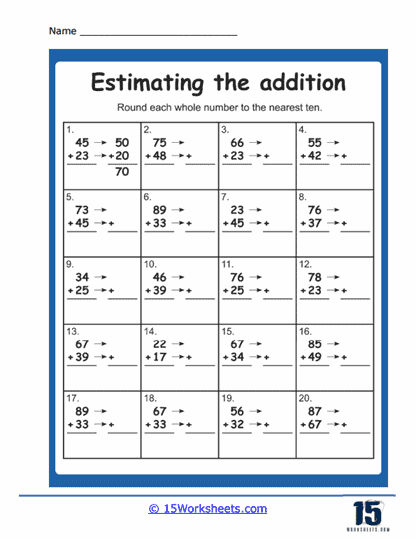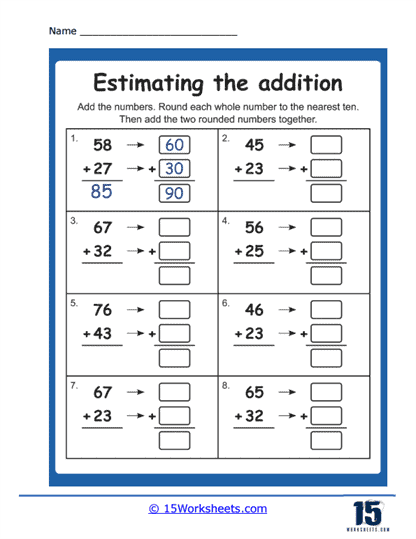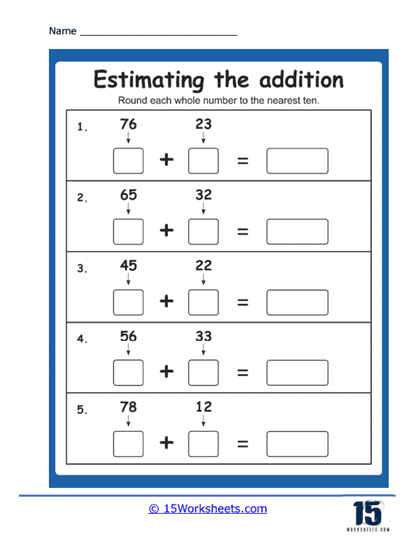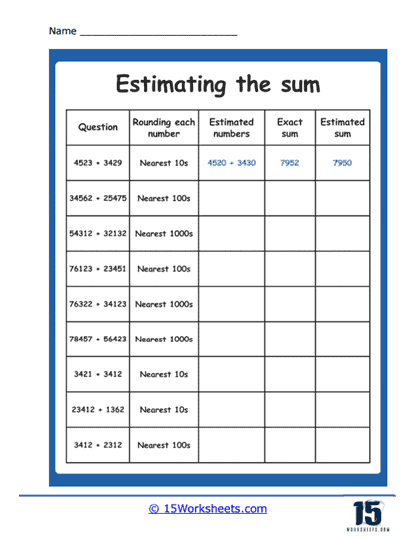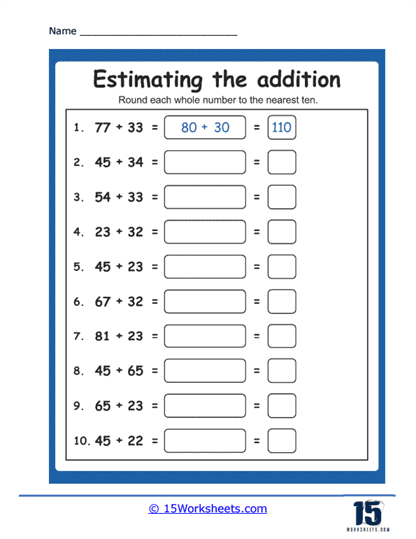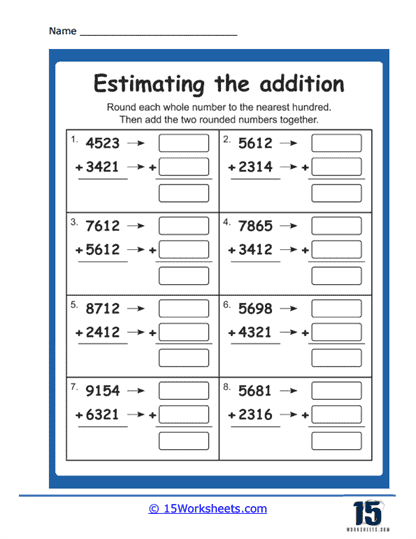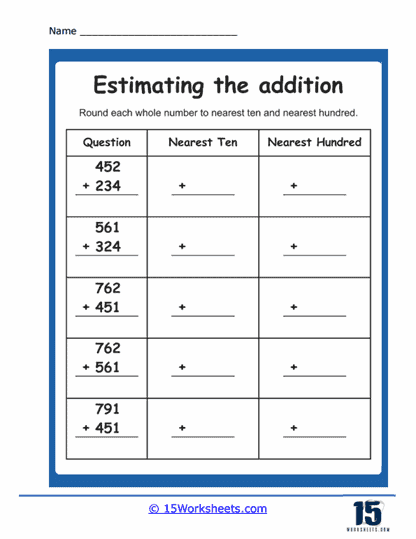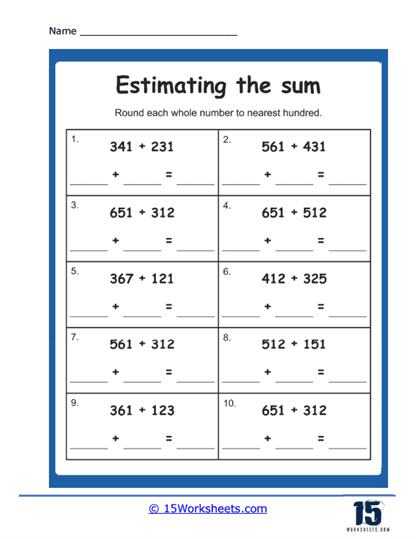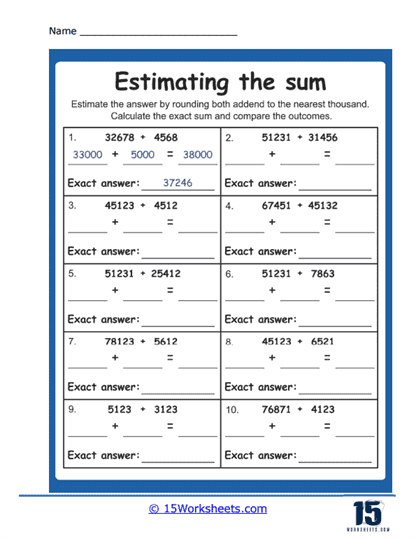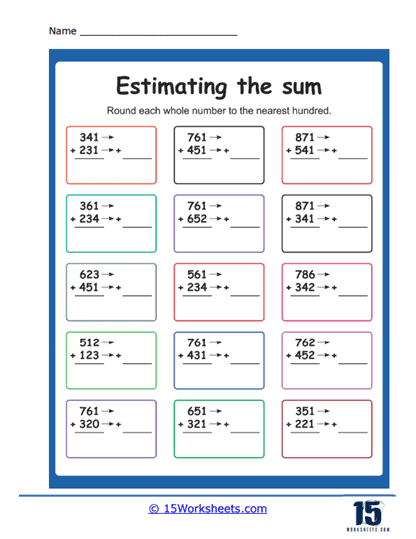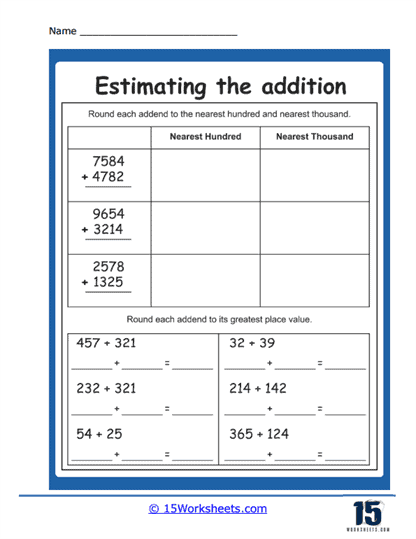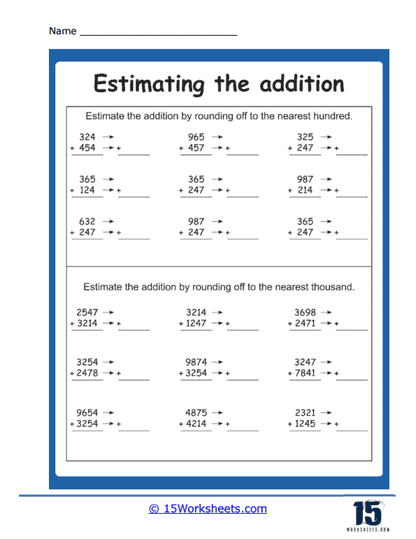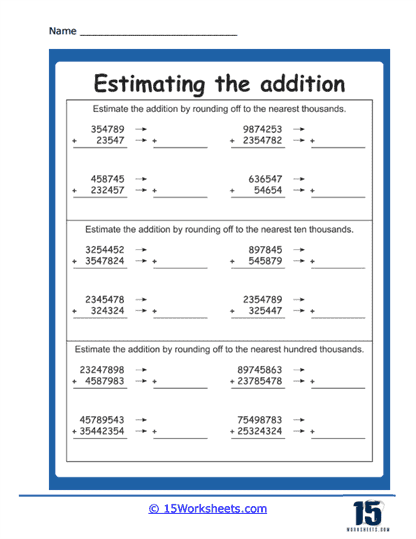Estimating Sums Worksheets
About These 15 Worksheets
As the name suggests, these worksheets contain problems where the aim is to estimate, or closely guess, the sum of two or more numbers, rather than calculating the exact sum. The outcomes of these problems are not exact. They are meant to give us a general idea or indication of some kind of trend. These worksheets are commonly used in mathematics education, particularly in elementary and middle school levels.
Why do we need to estimate sums when we can find the exact answer, you may ask? Well, sometimes, especially when dealing with large or complex numbers, it is easier and quicker to estimate. It can help us make quick decisions or assessments, especially in real-life scenarios. Not to mention, estimation is an excellent tool for checking the reasonableness of our answers.
A Quick Look At The Worksheets
Here is a quick look at the skills that this collection of worksheets focuses on:
1. Rounding Up the Basics
(Subtracting Tens • Nearest Tens • Tens and Hundreds Addition)
We begin our estimation adventure with the building blocks of rounding. In Subtracting Tens, students learn that subtracting multiples of 10 isn’t terrifying-it’s actually pretty satisfying. It’s like tidying up messy numbers and watching them fall into line. Nearest Tens then comes in like a number-themed GPS: students take numbers, eyeball their closest ten, and make judgment calls that would impress a seasoned poker player. And when Tens and Hundreds Addition shows up, it’s a family reunion-except the tens, hundreds, and sums actually get along. These worksheets are foundational, friendly, and secretly brilliant at easing students into estimation without panic or calculators.
2. The Great Estimation Showdown
(Estimate vs. Exact Sums • Estimate vs. Actual Adding • Big Sum Estimation)
Now things get spicy. These worksheets dive into the classic face-off: “What you think the answer is” vs. “What it actually is.” In Estimate vs. Exact Sums, students guess a sum, do the math, and then gasp in awe-or mild horror-at the truth. Estimate vs. Actual Adding doubles the drama by challenging students to reflect: why was their estimate close… or hilariously wrong? Then comes Big Sum Estimation, where the numbers get bulky, like math on protein shakes. Estimating becomes a test of number sense, judgment, and the humility to say, “Well, I was kind of close!”
3. Clever Tactics and Estimation Tricks
(Left to Right • Down and Over • Multiple Choice Sums)
With confidence rising, students get to explore quirky and powerful strategies. Left to Right flips the usual math order and says, “Hey, let’s estimate from the front digits first”-a radical approach that actually works like a charm. Down and Over has students shifting place values like little numerical ninjas-slide a digit here, drop one there, and poof, a close-enough estimate appears. And then Multiple Choice Sums brings in the game-show energy. Students pick the best estimate from a group, sharpening their speed and logic like fast-thinking quiz champs.
4. Thousand-Level Thinkers
(Estimating Thousands Sums • Estimating Thousands Sums)
Yes, there are two worksheets with the same name-and that’s not a typo, it’s a statement. Estimating numbers in the thousands is so important, it gets double billing. These worksheets crank up the mental math challenge. Students are rounding 4,873 or 6,219 to the nearest thousand and realizing that “close enough” has layers. It’s about scale, confidence, and getting used to math that feels like it’s wearing grown-up pants. Estimating at this level helps students make sense of bigger numbers in real-world situations (like population stats or, dare we say, pizza party budgets).
5. Practice, Tools, and Mastery
(Sum Estimation Chart • Pop and Add • Hundreds Practice • Estimating Sums Skills)
To wrap it all up, we’ve got the practice zone-where fluency is forged. Sum Estimation Chart turns estimation into a science experiment, letting students track and compare results with satisfying order. Pop and Add is the energetic cousin of flashcards, tossing quick estimates like popcorn kernels and asking students to react fast. Hundreds Practice keeps it grounded, drilling comfort with mid-range numbers before they leap back into the thousands. And finally, Estimating Sums Skills is the grand boss level: a comprehensive challenge that pulls everything together into one neat, empowering assessment of how far students have come.
How to Estimate Sums
In everyday life, you don’t always need an exact answer-sometimes, you just need a quick, close-enough estimate. Estimating sums is a handy skill that helps you do mental math, check your work, and make fast decisions (like budgeting or grocery shopping).
1. Round each number to the nearest ten, hundred, or another place value that makes sense.
2. Add the rounded numbers.
3. That result is your estimated sum.
Example 1: Estimating with Two Numbers
Problem: Estimate the sum of 246 and 589.
Step 1: Round the numbers
246 rounds to 250
589 rounds to 590
Step 2: Add the rounded numbers
250 + 590 = 840
Estimated sum: 840
(Actual sum is 835 – very close!)
Example 2: Estimating with Bigger Numbers
Problem: Estimate the sum of 3,241 and 1,762.
Step 1: Round to the nearest hundred
3,241 rounds to 3,200
1,762 rounds to 1,800
Step 2: Add
3,200 + 1,800 = 5,000
Estimated sum: 5,000
(Actual sum is 5,003 – again, very close!)
Example 3: Word Problem
Tina is buying supplies for a party. She picks up napkins for $4.79, cups for $5.25, plates for $8.99, and decorations for $10.49. About how much will she spend in total?
Step 1: Round the prices
$4.79 —> $5
$5.25 —> $5
$8.99 —> $9
$10.49 —> $10
Step 2: Add the estimates
5 + 5 + 9 + 10 = $29
Estimated total cost: $29
(Actual total is $29.52)

